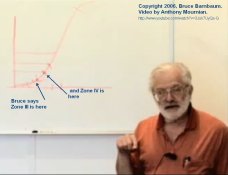I understand that, in practice, it's a good choice to take the shadows zones as references. However, when building the density x exposure graph, I thought that a more 'rigorous' approach would be adopted. I mean, I had thought the Zone V should be taken as reference because it is the one that may be compared to the standard middle gray card.
[With color negative film testing a gray card is used, because color development is a certain time that keeps colors in balance].
Two things you find out when doing black and white film testing: The film speed, and how long to develop.
Testing the shadow tells you the film speed. The "official" film speed tests use the shadow too. The meter relates film speed to gray Zone V.
Shadow detail doesn't change much when you develop more or less, so film speed test is a good test to do first.
When building the density x exposure graph, many of us use a 21-step Stouffer wedge, each step is a half f/stop. This gives plenty of information about everything from the shadow to the highlight. When done, you have a graph that tells you the density you get for the exposure.
There isn't a scientific way to match a paper to print on or to pick paper grade based on density of a negative. But developing your negatives so that they "fit" on a middle grade of paper gets you a negative that is possible to make a good print from.












